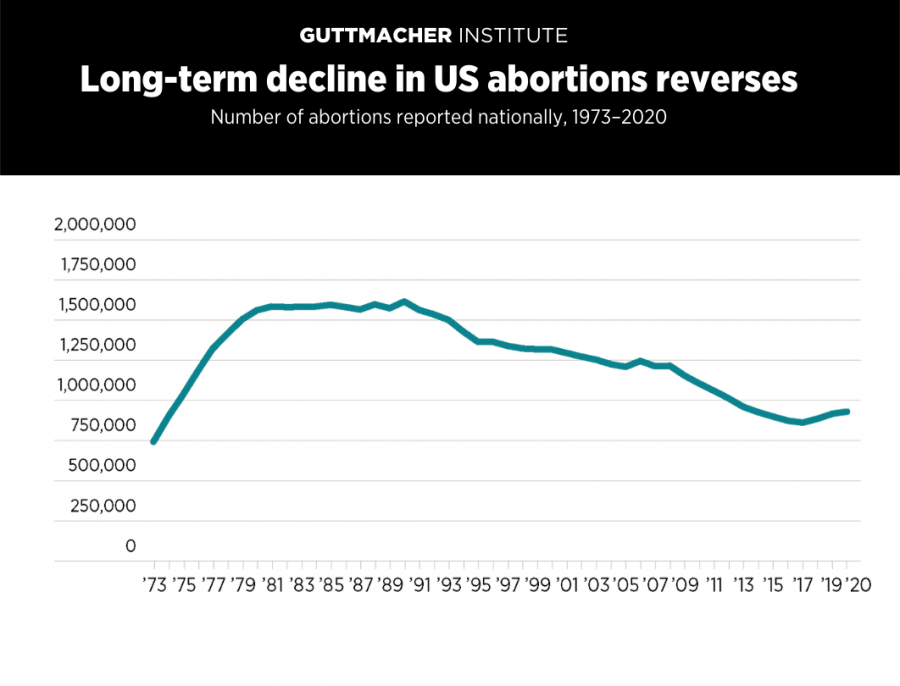
A new report released last week by the Guttmacher Institute shows the number of abortions in the United States increased by 8 percent during the Trump-Pence administration—from 862,320 in 2017 to 930,160 in 2020. Overall, fewer people became pregnant, but among those who did, a larger proportion chose to have an abortion. About one in five pregnancies in 2020 ended in abortion. Guttmacher’s Abortion Provider Census is the most comprehensive data collection effort on abortion provision in the U.S.
“An increase in abortion numbers is a positive development if it means people are getting the healthcare they want and need,” wrote the authors of the study.
Researchers suggest several factors may have contributed to this increase, including more unintended pregnancies due to the Trump-Pence administration’s “domestic gag rule.” which dramatically slashed Title X family planning services and access to contraception. Other possible factors include expanded access to Medicaid coverage of abortion healthcare in blue states and impacts of the COVID-19 pandemic.
This research reveals a dramatic reversal of a 30-year trend of declining numbers of abortion, “underscoring that the need for abortion care in the United States is growing just as the U.S. Supreme Court appears likely to overturn or gut Roe v. Wade,” according to the Guttmacher report.

A draft opinion in Dobbs v. Jackson Women’s Health Organization leaked in early May indicated that the Supreme Court was preparing to overturn the 49-year-old precedent Roe v. Wade, which recognized the constitutional right to abortion healthcare. States legislatures have passed a record-breaking number of restrictions this year, including abortion bans and civil bounty hunter laws in Texas and Oklahoma. If Roe is overturned, 26 states are certain or likely to ban abortion, and Republican leaders have already stated they will push for a nationwide abortion ban covering all 50 states.
“Rather than focusing on reducing abortion, policies should instead center the needs of people and protect their right to bodily autonomy,” wrote the Guttmacher researchers.
According to the report, the number of abortions increased in all four regions of the country between 2017 and 2020. The rise was largest in the West (12 percent increase) and Midwest (10 percent increase); abortions increased 8 percent in the South and 2 percent in the Northeast.
But there was significant variation across and within states. In some states—including Illinois, Mississippi and Oklahoma—there were substantial increases in the number of abortions. In others—such as Missouri, Oregon and South Dakota—there were substantially fewer abortions in 2020 compared with 2017.
Expanded Medicaid coverage of abortion healthcare likely contributed to more abortions in some states, including a 25 percent increase in Illinois and a 16 percent increase in Maine, which also required private health insurance plans to cover abortion healthcare for the first time.
The increased number of abortions in Illinois was also due to people coming from nearby states that imposed new restrictions, such as Missouri, where the number of abortions decreased from 4,710 in 2017 to 170 in 2020.
Illinois actually increased the number of clinics from 25 in 2017 to 30 in 2020. (A recent study showed that overall, the number of abortion facilities in the United States increased from 774 in 2017 to 790 in 2021, but with significant geographic variation).
COVID-19 had varying impacts on abortion numbers across states. In hard-hit New York, where at least 10 percent of clinics paused or stopped providing abortion care early in the pandemic, the number of abortions dropped six percent between 2019 and 2020. Meanwhile, the number of abortions dropped in states like Texas and Alabama, which imposed COVID-19 restrictions on abortion healthcare, falsely deemed “nonessential,” but the number of abortions in surrounding states increased, likely due to women traveling from restrictive states to find abortion healthcare.
The Guttmacher researchers noted other factors that likely contributed to state variation and overall increase in the number of abortions, including increased fundraising by local and national abortion funds so they could help more people pay for their abortions, increased abortion restrictions and bans (25 states enacted 168 laws between 2017 and 2020, some of which were blocked by courts), and 75 new provisions to protect abortion rights (repealing restrictions, expanding insurance coverage and allowing more qualified clinicians such as nurse practitioners, physician assistants or certified nurse midwives to provide at least some abortion care).
“The Supreme Court is poised to overturn Roe v. Wade at a time when need for abortion care has been increasing,” concluded the report. “This means the impact of the ruling could be even more devastating than predicted by prior analyses, particularly for people across the country who already struggle to access abortion care.”
Sign and share Ms.’s relaunched “We Have Had Abortions” petition—whether you yourself have had an abortion, or simply stand in solidarity with those who have—to let the Supreme Court, Congress and the White House know: We will not give up the right to safe, legal, accessible abortion.
Up next:





